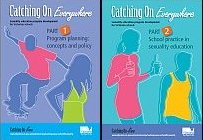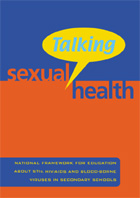This page provides support materials to assist teachers and school staff in designing and developing a school’s sexuality education program.
School-based sexuality education programs
Sexuality education programs must be included in primary, secondary and special schools and are developmentally appropriate. Primary school programs provide a necessary foundation for programs offered in secondary schools.
For materials and resources to support learning and teaching activities, and assessment and reporting in sexuality education, see:
Learning and Teaching
Towards a whole-school sexuality education program
The most effective sexuality education programs utilise a whole-school learning approach. When school leaders and teachers adopt such an approach, they view student learning in the context of the whole experience of being at school, that is, in the classroom, in the school environment, in the way a school responds to critical incidents and in the kinds of partnerships a school forms with the local community.
The following diagram provides an overview of whole-school learning in sexuality education.
A broader version of the Whole-school Sexuality Education Model is available on the
About Sexuality Education page.
Catching On Everywhere program development resource

This resource is designed to assist primary and secondary school principals and teaching staff in the development and maintenance of a comprehensive sexuality education program.
Catching on everywhere (part 1) provides a background to the project, a literature review and an outline of the sexuality education policy environment.
Catching on everywhere (part 2) provides school case studies, the model for whole-school learning in sexuality education, a suggested three-year program development plan and a curriculum audit tool.
Health-promoting schools framework
Whole-school learning in sexuality education is a health promotion strategy based on the health promoting schools framework. The protocols and guidelines for health promoting schools that underpins this framework (developed by the International Union for Health Promotion and Education France) were updated in 2008. See:
Australian Council for Health, Physical Education and Recreation
Further useful health promotion websites and links:
Educational goal
The primary goal of the school-based sexuality education program is to build on knowledge, skills, and behaviours, thus enabling young people to make responsible and safe choices.
See: School policy and advisory guide
Health Education Approaches
Sexuality education aims to prepare students for a sexually healthy adulthood. Assessment of student achievement is reported against the learning standards within the health and physical education domain of the Victorian essential learning standards.
National framework for secondary schools

The Talking Sexual Health framework resource has been developed by the Australian Research Centre in Sex, Health and Society at La Trobe University, Victoria, for the Australian National Council for AIDS, Hepatitis C and Related Diseases (ANCAHRD). This Department provided strong input into its development. It is provided here with permission from the Australian Government Department of Health and Ageing.
The purpose of the framework is to support secondary schools to implement education programs that reflect the complexity of issues related to sexuality education.
The framework has five key components for the development and delivery of comprehensive sexuality education:
- taking a whole-school approach
- acknowledging young people as sexual beings
- acknowledging and catering for the diversity of all students
- providing an appropriate and comprehensive curriculum context
- acknowledging the professional learning needs of the school community.
For further talking sexual health resources, see:
Primary school programs
Primary school programs and the national framework
The talking sexual health national framework is designed to assist in the provision of education for secondary school students. However, as health and sexuality education does not suddenly begin in secondary school, it is appropriate and desirable for those involved in the provision of primary school education to be familiar with the theoretical understandings presented in the document and adapt it to their needs.
The Bass Coast Model
Respecting diversity in sexuality education programs
To be meaningful for all, it is essential to ensure school-based sexuality education programs recognise and respond to diverse student needs. Forms of diversity include gender, culture, religion, disability and sexual orientation.
In 2006, the Department hosted the successful ‘Sense and Sexuality – A conference on sexual diversity in schools’. Associate Professor Ray Misson, Faculty of Education, Melbourne University, delivered the key address: ‘Pride, Prejudice and Persuasion’. The address explores the roles policy, schools and teachers can play in managing sexual diversity in schools. See:
 Pride, Prejudice and Persuasion (pdf - 44.63kb)
Pride, Prejudice and Persuasion (pdf - 44.63kb)
Specific resources to assist with the inclusion of sexual diversity in a school’s sexuality education program are available on the following pages of this website:
For research that underlines the importance of sexuality education that is inclusive and respectful of sexual diversity, see:
Why we Need Sexuality Education
Comprehensive, whole-school sexuality education that provides consistent and accurate information to all young Victorians from an early age, and is respectful of diversity, can contribute to behaviour change.
Sexuality education programs and suicide prevention
Health education
Schools, through inclusive sexuality education and health and physical education programs, minimise suicide risk by further increasing knowledge and skills related to adolescent development, promoting healthy choices, resilience, and respect and acceptance of others.
Homophobia and transphobia
The effects of homophobia and transphobia can impact a person’s self-acceptance and self-esteem and consequently on their will to live, their outlook on the future and their ability to deal with day-to-day life.
Same-sex attraction and suicidal ideation
Same-sex attracted young people can be particularly at risk of suicidal thoughts at key stages of their development. It has been found that life episodes that may correlate with suicide ideation include:
- following admission to self of same-sex attraction or non-conforming gender identity. Acknowledging a non-conforming sexual or gender identity places great stress on the individual and can be accompanied by a sense of shame, guilt and self-loathing
- following 'coming out' which may lead to isolation from family and peer support
- following failed attempts to connect with the gay, lesbian, transgender or bisexual community, groups or individuals.
For more information, see:
Writing themselves in again - The second national report on the sexuality, health and wellbeing of same-sex attracted young people in Australia, provided by Gay and Lesbian Health Victoria.
Supporting resources
Sexuality education resources such as the catching on secondary school resource (DET) and talking sexual health (Australian Government) provide policy directions and teaching materials for schools, designed to promote an inclusive, whole-school approach to student learning. The talking sexual health national framework to assist in program implementation is provided above (under 'national framework for secondary schools').
For the teaching materials, see:
Learning and Teaching
Resources such as building respectful and safe schools: A resource for school communities (DET) and safety in our schools – strategies for responding to Homophobia (VicHealth) provide policy directions on student health and wellbeing.
See:
Creating Respectful and Safe Communities
Supporting professional learning
Teacher professional learning supporting the catching on and talking sexual health resources specifically addresses homophobia and suicidal ideation. The resources provide policy directions and teaching materials designed to assist students to develop some sense of their own and others’ attitudes and values. The more confident a same-sex attracted person is about their attractions, the lesser the likelihood they will seriously consider suicide.
For more information on training, see:
Professional Learning
Supporting policy
For more information on suicide prevention, see: School policy and advisory guide
Suicide Awareness Strategy